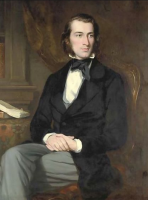










Matthew Piers Watt Boulton was a British classicist, elected member of the UK's Metaphysical Society, an amateur scientist and an inventor, best known for his invention of the aileron, a primary aeronautical flight control device. He patented the aileron in 1868, some 36 years before it was first employed in manned flight by Robert Esnault-Pelterie in 1904.
Early life
Boulton was born 22 September 1820 at Mose Old Norton, Staffordshire, England to Matthew Robinson Boulton (8 August 1770 – 16 May 1842) and Mary Anne Wilkinson (27 November 1795 – 7 June 1829).He was baptized at St. Mary's Church, Handsworth, Staffordshire on 9 November 1820. M.P.W.'s ancestors can be traced back to John Bolton (his surname missing the 'u', which was included one or two generations later) of Lichfield, Staffordshire, who married (the later-to-be wealthy) Elizabeth, daughter of Matthew Dyott of Stichbrooke, Staffordshire in the late 15th-century. John Bolton is believed descended from, possibly a grandson of Robert Bolton (1572 – 19 December 1631), rector of Broughton, Northamptonshire in 1609 until his death.
In October 1938 Boulton graduated to Trinity College (part of Cambridge University) where he undertook studies of mathematics, logic and the classics. His first tutor in Cambridge was the English mathematician George Peacock (then Cambridge's Lowndean Professor of Astronomy and a friend of Charles Babbage).Among Boulton's earliest accomplishments was earning the Eton Prize in February 1839 for his essay, The Decline and Fall of the Persian Empire,and an award for his collection of witty epigrams at Cambridge University in 1841.He also won two of Cambridge's Sir William Browne Medals for Latin and Greek poetry.Dr. Chris Upton of Birmhingham's Newman University wrote on Boulton's 1841 Latin poem Vehicula vi vaporis impulsa, roughly meaning "Vehicles driven by the power of steam".
Ailerons:
Boulton's description of his aileron control system was both clear and complete. It was "the first record we have of appreciation of the necessity for active lateral control as distinguished from [passive lateral stability].... With this invention of Boulton's we have the birth of the present-day three torque method of airborne control" as was praised by Charles Manly.This was also endorsed by C.H. Gibbs-Smith.
For the safety of aerial vessel it is important to provide a controlling power not only to direct their horizontal and vertical course, but also to prevent their turning over by rotating on the longitudinal axis. A certain stability of the kind desired is afforded by using an extended surface whose sides make an angle from the axis upwards.... But it is desirable to provide a more powerful action preventing [rolling] rotation of the body in this direction. For this purpose a rudder of the following construction may be adopted:—Vanes or movable surfaces are attached to arms projecting from the vessel laterally or at right angles to its length. When these vanes are not required to act they present their edges to the front, so as to offer little resistance to the vessel's movement, but if the vessel should begin to rotate on the longitudinal axis the vanes are moved so as to take inclined positions, those on the ascending side of the vessel being caused to rotate to such an inclination that the air impinging upon them exerts a pressure downwards, while those on the descending side are so inclined that the air impinging upon them exerts a pressure upwards, thus the balance of the vessel is redressed and its further rotation prevented. The vanes may be moved by hand or by self-acting mechanism.
Death:
M.P.W. Boulton died in London on 30 June 1894 at age 73.
Numerous Patents